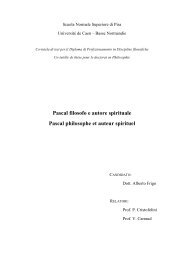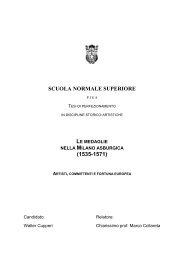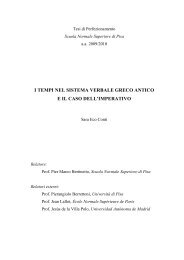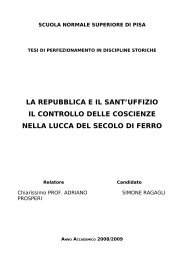CATULLUS 68 - Scuola Normale Superiore
CATULLUS 68 - Scuola Normale Superiore
CATULLUS 68 - Scuola Normale Superiore
Create successful ePaper yourself
Turn your PDF publications into a flip-book with our unique Google optimized e-Paper software.
What makes the image effective and slightly humorous is that old women were considered to be naturally<br />
talkative: if the papyrus sheet containing the poem will be an old woman, it will hardly be able to stop<br />
talking. Ancient literature abounds in talkative old women: note Aristoph. Thesm. 1073 πολε⇑! μ ∈ γρα⎝<br />
!τϖμυλλομϒνη, Callim. Hecale frg. 310 Pfeiffer = 58 Hollis ε⇔πλανα ξε⇔λεα γρη〉!, Plaut. Cist. 149<br />
utrumque haec, et multiloqua et multibiba, est anus, Mart. 11.50.8 garrula saga and the anus who is called a<br />
sermocinatrix inmodica at Apul. Met. 9.17. Cicero Sen. 55 lets Cato the Elder make the point that senectus<br />
est natura loquacior.<br />
charta ‘a sheet of papyrus’ comes from the Greek ξ ρτη!. In Latin the word remained in the first declension<br />
but became feminine; Lucilius 709 Marx still uses the masculine plural charti. The word is widespread, but<br />
less common in prose than in poetry before Apuleius, perhaps due to chance (cfr. TLL 3.997.5-9). Catullus<br />
also uses it at 1.6, 36.1 and 36.21. The principal MSS consistently spell the word as carta; however, it is<br />
written with a h in the MSS of Catullus’ contemporaries Lucretius (3.10, 4.790, 6.112 and 6.114) and Cicero<br />
(Cael. 40, Rab. Post. 40, Fam. 7.18.2, Att. 2.20.3 and 5.4.4, Q. fr. 2.15.1, frg. poet. 6.48 FPL 3 = Div. 1.40)<br />
and appears to have retained it in Lucilius’ Satires (709 and 1085 Marx), while Probus GL 4.10.20-22 lists<br />
charta among the nomina post c litteram habentia h. The unaspirated form is preferred by the MSS of the<br />
Rhetorica ad Herennium (3.30.8). The epigraphic evidence is ambiguous (see TLL 3.996.73-81), but of<br />
doubtful value in this case, as CE 972.5 charte, which is listed in the Thesaurus as the only possible<br />
attestation of the word on an inscription from the 1 st century B.C., could well date from the Renaissance (cfr.<br />
Buecheler ad loc. in CE). Cremona (1958: 431f., with n. 130) notes that we are dealing with an old loan-<br />
word, already acclimatized in Latin, and like purpura, ampora, tus and Poeni, deprived of its aspiration.<br />
However, Catullus appears to have had a strong sense of propriety in using or omitting aspirations (cfr. poem<br />
84) and the balance of evidence combined with the origin of the word strongly suggests that educated<br />
speakers of Latin in the mid-1 st century B.C. would have preferred the aspirated form. The MSS’ carta could<br />
well be a Medieval innovation.<br />
Note the assonance in haec charta.<br />
Statius’ ingenious conjecture cera ‘wax (tablet)’ rests on the belief that tabellis pro chartis utebantur antiqui<br />
(Festus p. 542 Thewrewk = pp. 490-492 Lindsay). Catullus indeed talks of writing on tablets (50.2, cfr. 42)<br />
but papyrus sheets appear to have been used quite widely in this period, even for private letters, witness Cic.<br />
Fam. 7.18.2 miror quid in illa chartula fuerit quod delere malueris quam haec scribere, Att. 2.20.3<br />
charta ipsa ne nos prodat pertimesco and Q. fr. 2.15.1 calamo et atramento temperato, charta etiam dentata<br />
(‘on polished paper’) res agatur. In any case a poem reached the public written on papyrus and not on<br />
perishable wax tablets; this was the format in which Catullus could expect this composition to become<br />
famous.<br />
These words could well be echoing a passage from Laevius’ Protesilaodamia, frg. 13 FPL 3 fac<br />
papyrin haec terga habeant stigmata. These highly obscure words have been interpreted in a variety<br />
of ways (see Frassinetti 1974: 315-317 and Courtney 1993: 130f.); on the basis of this parallel and phrases<br />
such as linea terga (Verg. Aen. 10.784) and aerea terga / loricae (Stat. Theb. 9.552f., where some editors<br />
161






